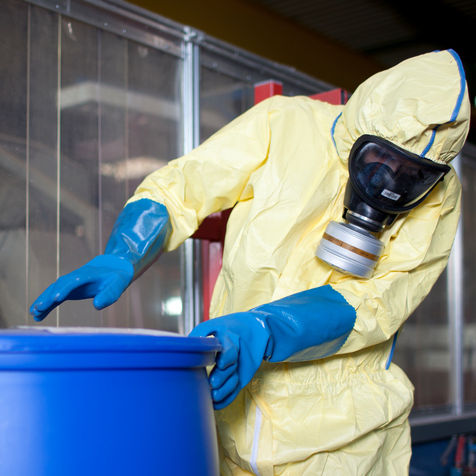06.B.02
When engineering and work practice controls or substitution are either infeasible or insufficient, appropriate PPE and chemical hygiene facilities must be provided and used for the transportation, use, and storage of hazardous or toxic agents.
- When irritants or hazardous substances may contact skin or clothing, chemical hygiene facilities and PPE must be provided. PPE may include suitable gloves, face/eye protection and chemical protective suits.
- (1) The qualified IH or other competent person must determine the scope and type of PPE required.
- (2) Special attention must be given to selecting proper chemical protection when working with materials designated with a "skin" notation by OEL. Such materials may produce systemic toxic effects through absorption through unbroken skin. See Section 5.
- (3) Before commencing use of epoxy resins, concrete, or other dermatitis-producing substances, employees must be made aware of the manufacturer's skin protection recommendations. Barrier cream ointment or other skin protection measures recommended by the manufacturer for the specific exposure must be available for use.
- When eyes or body of any person may be exposed to hazardous or toxic agents, suitable facilities that comply with ANSI Z358.1, Emergency Eyewash and Shower Equipment, for quick drenching or flushing of the eyes and body must be provided in the work area for immediate emergency use and must be no more than 10 seconds from the hazardous material. See ANSI Z358.1.
- (1) Emergency eyewash equipment must be provided where there is the potential for an employee's eyes to be exposed to corrosives, strong irritants, or toxic chemicals.
- (2) The emergency eyewash equipment must irrigate and flush both eyes simultaneously while the operator holds the eyes open.
- (3) The emergency eyewash equipment must deliver at least 0.4 gal (1.5 L) of water per minute for 15 minutes or more, providing a minimum of 6 gal (22.7 L) of water).
- (4) Water used in emergency eyewashes and showers must meet drinking water standards. When these items are exposed to the elements, steps will be taken to ensure the water does not freeze or become stagnate.
- (5) Personal eyewash equipment may be used to supplement emergency washing facilities. They must not be used as a substitute. Personal eyewash fluids must be visually inspected monthly to ensure they remain sanitary with no visible sediments.
- (6)All plumbed emergency eyewash facilities and hand-held drench hoses must be connected to an approved potable water supply and activated weekly and inspected annually to ensure that they function correctly and that the quality and quantity of water is satisfactory for emergency washing purposes.
- When personal protective clothing is required:
- (1) An area must be established for the removal of the personal protective clothing which limits the spread of any chemical waste, dust, or fume;
- (2) Workers must be trained in the removal of personal protective clothing and equipment to prevent further spread or contamination.
Knowledge Check Choose the best answer for the question.
6-4. If exposed to hazardous or toxic agents, how soon must employees be able to reach and use emergency eyewash and shower equipment?
You forgot to answer the question!

